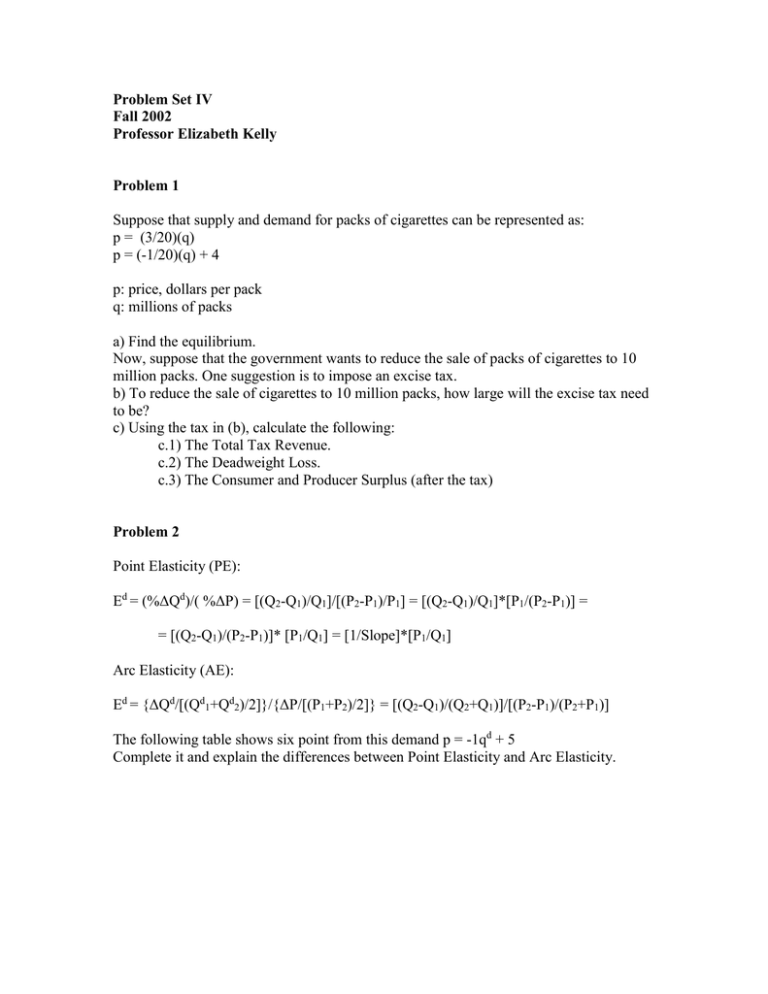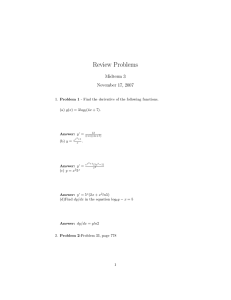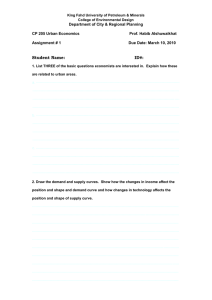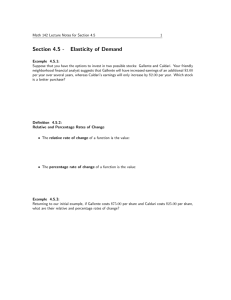Problem Set IV Fall 2002 Professor Elizabeth Kelly Problem 1
advertisement

Problem Set IV
Fall 2002
Professor Elizabeth Kelly
Problem 1
Suppose that supply and demand for packs of cigarettes can be represented as:
p = (3/20)(q)
p = (-1/20)(q) + 4
p: price, dollars per pack
q: millions of packs
a) Find the equilibrium.
Now, suppose that the government wants to reduce the sale of packs of cigarettes to 10
million packs. One suggestion is to impose an excise tax.
b) To reduce the sale of cigarettes to 10 million packs, how large will the excise tax need
to be?
c) Using the tax in (b), calculate the following:
c.1) The Total Tax Revenue.
c.2) The Deadweight Loss.
c.3) The Consumer and Producer Surplus (after the tax)
Problem 2
Point Elasticity (PE):
Ed = (%ΔQd)/( %ΔP) = [(Q2-Q1)/Q1]/[(P2-P1)/P1] = [(Q2-Q1)/Q1]*[P1/(P2-P1)] =
= [(Q2-Q1)/(P2-P1)]* [P1/Q1] = [1/Slope]*[P1/Q1]
Arc Elasticity (AE):
Ed = {ΔQd/[(Qd1+Qd2)/2]}/{ΔP/[(P1+P2)/2]} = [(Q2-Q1)/(Q2+Q1)]/[(P2-P1)/(P2+P1)]
The following table shows six point from this demand p = -1qd + 5
Complete it and explain the differences between Point Elasticity and Arc Elasticity.
Q
A
B
C
D
E
F
P
0
1
2
3
4
5
(*)
Point
Elasticity
5
4
3 From B to C
2 From C to D
1 From D to E
0 From E to F
Point
Arc
Arc
(*)
Elasticity
Elasticity
Elasticity
From B to A
From B to A
From C to B
From A to B
From C to B
From D to C
From B to C
From D to C
From E to D
From C to D
From E to D
From D to E
From F to E
From E to F
(*) First point given is (Q1, P1): e.g. from B to C, the coordinates of point B=(1,4)=(Q1, P1)
Problem 3
Suppose that apples’ supply and demand can be represented as:
p= q
p = -2q + 15
p: price, dollars per pound
q: millions of pounds
a) Find the equilibrium.
b) Find the Total Revenue of the farmers.
Part I
Now, suppose that Congress will discuss this week how to increase the Total Revenue of
farmers. One of the Congressional proposals is to enact a price floor.
Suppose the price floor is set at a price equal to $1 more per unit than the equilibrium
price that you found in part a).
c) How will the quantity demanded respond to this increase?
d) Compare the percentage change in the quantity demanded to the percentage change in
the price of the good in absolute value terms. Is the demand curve elastic or inelastic at
this point?
e) Find the Total Revenue of the farmers.
Part II
Now, suppose that the equilibrium point is:
(q=15/4, p=15/2)
Again, suppose that Congress will discuss this week how to increase the Total Revenue
of farmers. A Congressional proposal is to enact a price floor equal to $1 more per unit
than the new equilibrium price of $ 15/2.
f) Using the original demand curve, how will the quantity demanded respond to this
increase?
g) What happens to the total revenue of farmers with this policy? Explain the relationship
between your answer and demand elasticity.
Part III
Now, suppose that the equilibrium point is:
(q=13/4, p=17/2)
Again, suppose that Congress will discuss this week how to increase the Total Revenue
of farmers. A Congressional proposal is to enact a price floor equal to $1 more per unit
than the new equilibrium price of $ 17/2.
h) How will the quantity demanded respond to this increase?
i) What happens to the total revenue of farmers with this policy? Explain the relationship
between your answer and demand elasticity.
j) Compare Part I and Part III.
Why are the results of the suggested policies so different? I.e., in Part I Total Revenue
goes up and in Part III the Total Revenue goes down.




